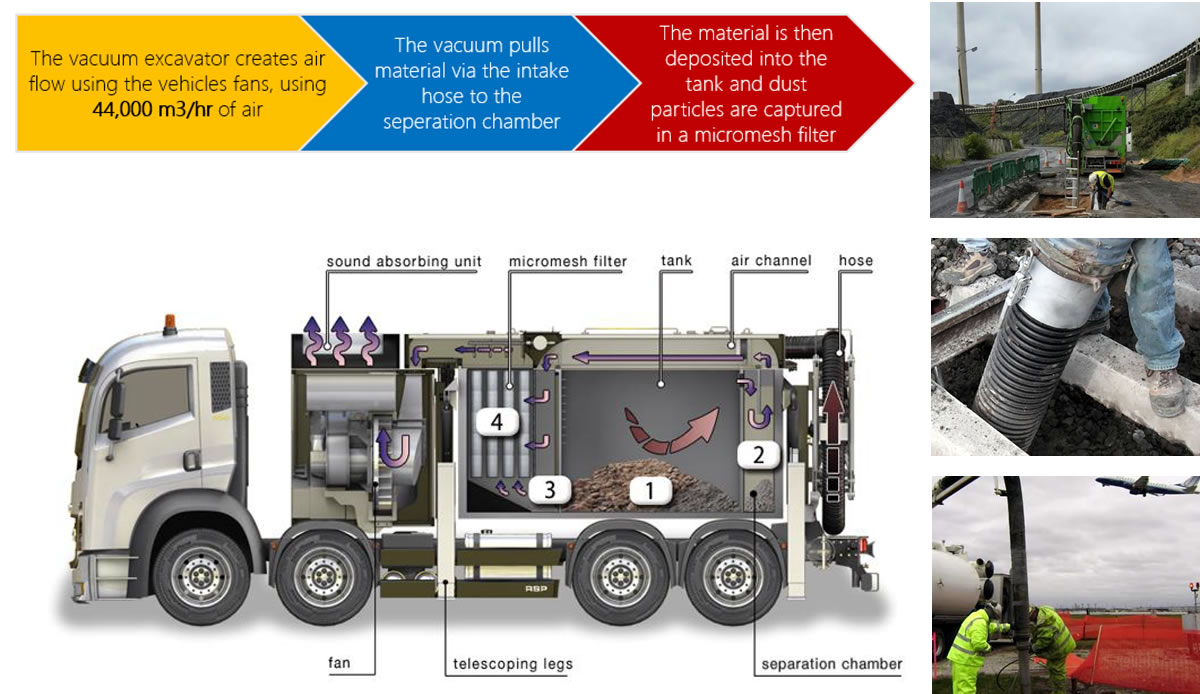Vacuum excavation is a non-invasive technology ideally suited for excavation work on sites where existing buried pipe, cable and other utilities are present.
The photographs below illustrate one of our vacuum excavators being used on the Dublin City Luas Utility Diversion Project, which was a complex undertaking to divert the myriad of utilities (water, gas, power, telecoms and sewer) to facilitate the new rail tracks.
 Traditional methods of excavation can be cumbersome, messy, and potentially dangerous and could damage the very utilities you are trying to locate or repair.
Traditional methods of excavation can be cumbersome, messy, and potentially dangerous and could damage the very utilities you are trying to locate or repair.
The key benefits of vacuum excavation are:
-
The excavation process can be finely controlled and the size of the excavation and the volume of material removed are therefore minimized. As less spoils is excavated this results in reduced reinstatement costs and reduced environmental impact.
-
The speed and flexibility of the excavator is ideal for works in high-profile locations and for works in the vicinity of sensitive structures. Urban sites are often complicated by restricted and difficult access. The excavator’s telescopic reach and flexibility means it can be effective in many areas where mechanically assisted excavation is compromised.
-
As the excavation is far less labour intensive there is a significant reduction to many health and safety risks. Many utility companies and airport operators throughout Ireland and the United Kingdom now insist on the use of vacuum excavation rather than invasive methods. This is due to the minimised disruption, reduced reinstatement requirements and improved safety that vacuum excavation offers.
Orchard Pipelines are leading the way in making excavation safe, efficient, less costly and protective of the buried infrastructure.
Vacuum excavators are designed and manufactured using special suction fans that create the negative pressure and air flow to transport material. The suction fans are driven via an engine driven power and are capable of creating an airflow of up to 44,000m³ per hour.
This air flow enables the operator to vacuum liquids or solids up to 250 mm in diameter through the air intake suction nozzle.
The excavated material is deposited directly into the main collection chamber on board the vehicle due to the drop in air pressure and circulation. The air is then deflected through the air outlet chambers to clean, dry and remove the finer particles. The fine filter system separates the finest dust from the airflow before the clean air travels through the fan assembly. The purified air then travels through a special air outlet silencer before returning to the atmosphere. The main collection chamber is then discharged, normally into low level skips for recycling.

Possible applications include:
- Safe excavation around buried utilities
- Excavation works in restricted conditions
- Trial holes and inspection pits
- Railway line ballast removal
- Construction Projects
- Working in vicinity of tree roots
- Culvert\gully clearing
- Sewer slit removal
- Airport apron utility excavations (excavated material contained in vehicle and not at side of trench)
Our clients include:
- ESB Networks
- GMC Utilities Group
- BAM Group
- Intel
- Sisk
- LUAS light rail
- Network Rail
- Cardiff Airport
- Dublin City Council
- Irish Water
- Moneypoint Power Station
